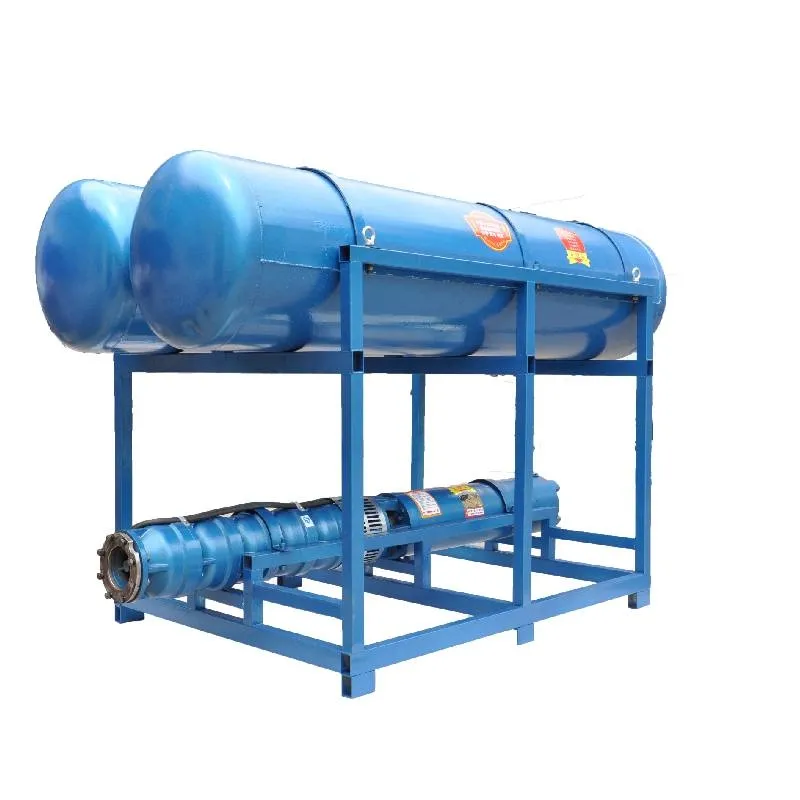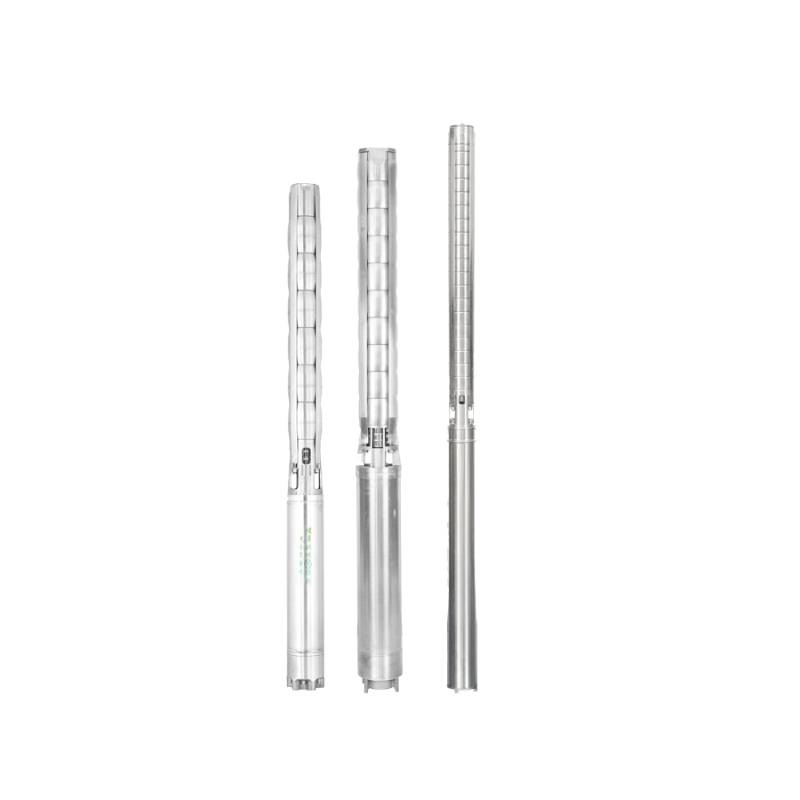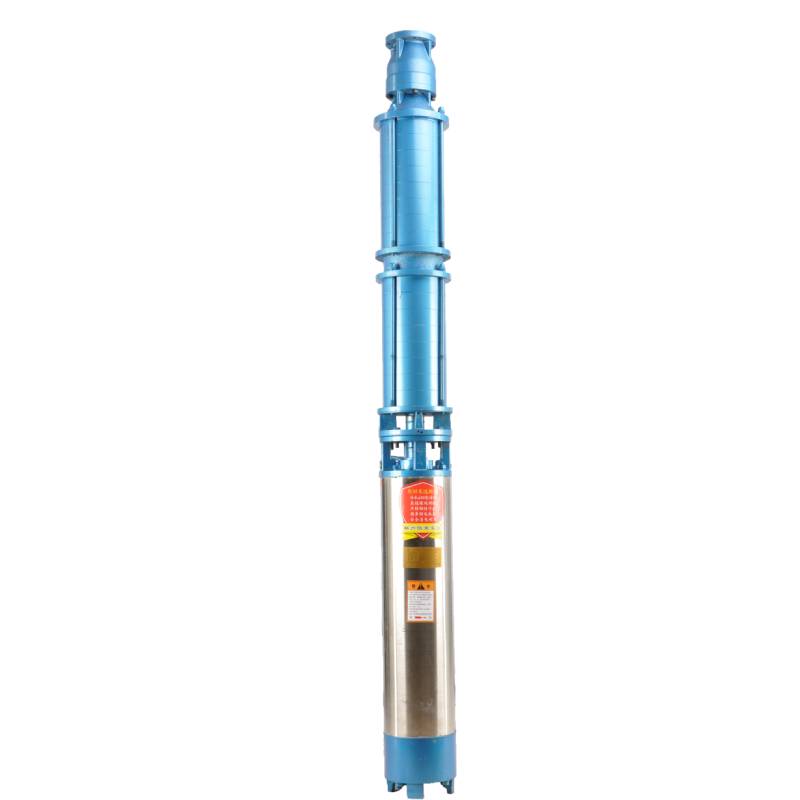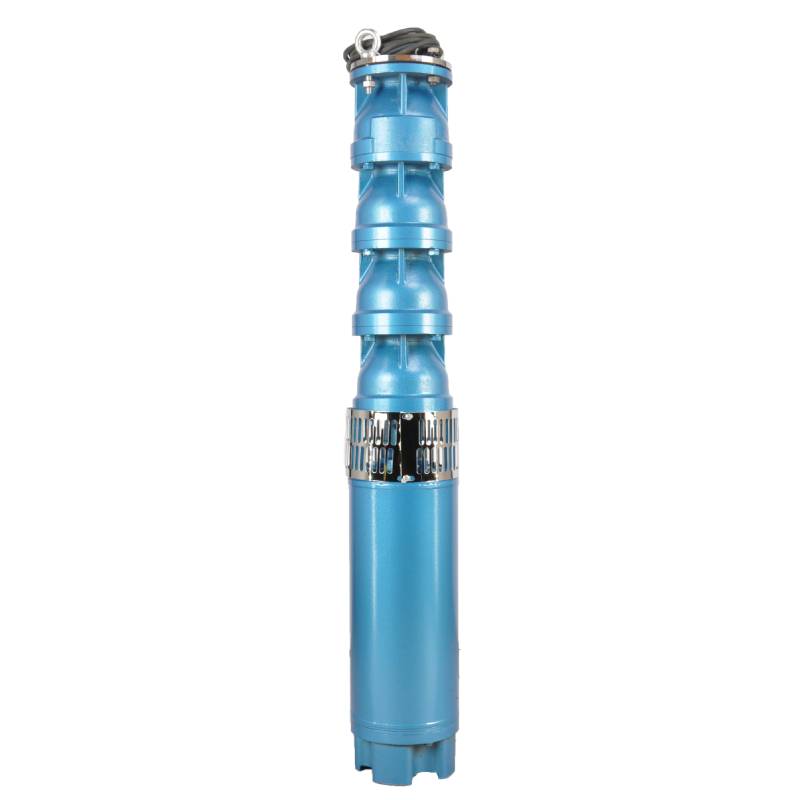This product adopts variable frequency winding design, ensuring the motor stable long-term conversion operation between 1HZ-50HZ. Its characteristics of energy saving and prolonged service life make it an ideal choice. Through this design, users can achieve efficient energy utilization while prolonging the service life of the product, which meets the modern society's demand for environmental protection and sustainable development. Whether for industrial production or home use, this product will bring users more convenient and efficient experience, becoming the leading choice in the industry.
This three-phase AC 380V (tolerance ± 5%), 50HZ (tolerance ± 1%) submersible pump is a reliable pump equipment, can be used in a variety of application scenarios. In terms of the use of conditions, to ensure good water quality, including water temperature is not higher than 20 °C, solid impurities content is not more than 0.01%, pH value is 6.5-8.5, hydrogen sulfide content is not more than 1.5mg / L, chloride ion content is not more than 400mg / L. The motor adopts a closed or water-filled wet structure, the inner cavity must be filled with clean water before use to prevent false filling. The pump must be completely immersed in water, and the immersion depth shall not exceed 70m, the distance from the bottom of the pump and the bottom of the well shall not be less than 3m. The water source shall meet the requirements of the pump inflow and continuous operation, the pump water control in the rated flow of 0.7-1.2 times. The well must be vertical, the pump can not be used horizontally or tilted, only vertical use. The pump must be equipped with cables and external overload protection device as required. It is strictly prohibited to dry turn the pump test. The design of the equipment is safe and reliable, meets the use of standards, is an indispensable ideal choice in all kinds of engineering projects and industrial applications.
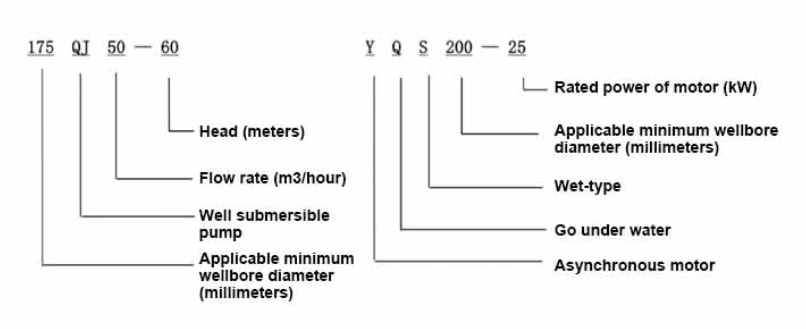
| Hoʻohālike | Kahe (m3/h) | Poʻo (m) |
Rotatingspeed(change/point) | Pum wai(%) | puka puka anawaena (mm) |
Kūpono maikaʻi anawaena(mm) |
Heluhelu ʻia power(KW) |
Heluhelu ʻia uila (V) |
Heluhelu ʻia kēia manawa(A) |
Kaʻa kaʻa (%) | power factorcosφ | Unite Ka nui o ka Radial (mm) |
ʻŌlelo | |||||||||
| 200QJ20-40 | 20 | 40 | 2850 | 66 | 50 | 200maluna | 4 | 380 | 10.1 | 76.0 | 0.79 | 184 | ||||||||||
| 200QJ20-54 | 54 | 5.5 | 13.6 | 77.0 | 0.8 | |||||||||||||||||
| 200QJ20-81 | 81 | 7.5 | 18.0 | 78.0 | 0.81 | |||||||||||||||||
| 200QJ20-93 | 93 | 9.2 | 21.7 | 78.5 | 0.82 | |||||||||||||||||
| 200QJ20-108 | 108 | 11 | 25.8 | 79.0 | 0.82 | |||||||||||||||||
| 200QJ20-121 | 121 | 13 | 29.8 | 80.0 | 0.83 | |||||||||||||||||
| 200QJ20-148 | 148 | 15 | 33.9 | 81.0 | 0.83 | |||||||||||||||||
| 200QJ20-175 | 175 | 18.5 | 41.6 | 81.5 | 0.83 | |||||||||||||||||
| 200QJ20-202 | 202 | 22 | 48.2 | 82.5 | 0.84 | |||||||||||||||||
| 200QJ20-243 | 243 | 25 | 54.5 | 83.0 | 0.84 | |||||||||||||||||
| 200QJ20-270 | 270 | 30 | 65.4 | 83.0 | 0.84 | |||||||||||||||||
| 200QJ20-360 | 360 | 37 | 79.7 | 84.0 | 0.84 | |||||||||||||||||
| 200QJ20-442 | 442 | 45 | 96.9 | 84.0 | 0.84 | |||||||||||||||||
| 200QJ25-28 | 25 | 28 | 2850 | 68 | 65 | 200maluna | 4 | 380 | 10.1 | 76.0 | 0.79 | 184 | ||||||||||
| 200QJ25-42 | 42 | 5.5 | 13.6 | 77.0 | 0.8 | |||||||||||||||||
| 200QJ25-56 | 56 | 7.5 | 18.0 | 78.0 | 0.81 | |||||||||||||||||
| 200QJ25-70 | 70 | 9.2 | 21.7 | 78.5 | 0.82 | |||||||||||||||||
| 200QJ25-98 | 98 | 11 | 25.8 | 79.0 | 0.82 | |||||||||||||||||
| 200QJ25-112 | 25 | 112 | 2850 | 68 | 65 | 200maluna | 13 | 380 | 29.8 | 80.0 | 0.83 | 184 | ||||||||||
| 200QJ25-126 | 126 | 15 | 33.9 | 81.0 | 0.83 | |||||||||||||||||
| 200QJ25-154 | 154 | 18.5 | 41.6 | 81.5 | 0.83 | |||||||||||||||||
| 200QJ25-182 | 182 | 22 | 48.2 | 82.5 | 0.84 | |||||||||||||||||
| 200QJ25-210 | 210 | 25 | 54.5 | 83.0 | 0.84 | |||||||||||||||||
| 200QJ25-252 | 252 | 30 | 65.4 | 83.0 | 0.84 | |||||||||||||||||
| 200QJ25-308 | 308 | 37 | 79.7 | 84.0 | 0.84 | |||||||||||||||||
| 200QJ25-378 | 378 | 45 | 96.9 | 84.0 | 0.84 | |||||||||||||||||
| 200QJ32-26 | 32 | 26 | 2850 | 70 | 80 | 200maluna | 4 | 380 | 10.1 | 76.0 | 0.79 | 184 | ||||||||||
| 200QJ32-39 | 39 | 5.5 | 13.6 | 77.0 | 0.8 | |||||||||||||||||
| 200QJ32-52 | 52 | 7.5 | 18.0 | 78.0 | 0.81 | |||||||||||||||||
| 200QJ32-65 | 65 | 9.2 | 21.7 | 78.5 | 0.82 | |||||||||||||||||
| 200QJ32-78 | 78 | 11 | 25.8 | 79.0 | 0.82 | |||||||||||||||||
| 200QJ32-91 | 91 | 13 | 29.8 | 80.0 | 0.83 | |||||||||||||||||
| 200QJ32-104 | 104 | 15 | 33.9 | 81.0 | 0.83 | |||||||||||||||||
| 200QJ32-130 | 130 | 18.5 | 41.6 | 81.5 | 0.83 | |||||||||||||||||
| 200QJ32-143 | 143 | 22 | 48.2 | 82.5 | 0.84 | |||||||||||||||||
| 200QJ32-169 | 169 | 25 | 54.5 | 83.0 | 0.84 | |||||||||||||||||
| 200QJ32-195 | 195 | 30 | 65.4 | 83.0 | 0.84 | |||||||||||||||||
| 200QJ32-247 | 247 | 37 | 79.7 | 84.0 | 0.84 | |||||||||||||||||
| 200QJ32-299 | 299 | 45 | 96.9 | 84.0 | 0.84 | |||||||||||||||||
| 200QJ40-26 | 40 | 26 | 2850 | 72 | 80 | 200maluna | 5.5 | 380 | 13.6 | 77.0 | 0.8 | 184 | ||||||||||
| 200QJ40-39 | 39 | 7.5 | 18.0 | 78.0 | 0.81 | |||||||||||||||||
| 200QJ40-52 | 52 | 9.2 | 21.7 | 78.5 | 0.82 | |||||||||||||||||
| 200QJ40-65 | 65 | 11 | 25.8 | 79.0 | 0.82 | |||||||||||||||||
| 200QJ40-78 | 78 | 15 | 33.9 | 81.0 | 0.83 | |||||||||||||||||
| 200QJ40-104 | 104 | 18.5 | 41.6 | 81.5 | 0.83 | |||||||||||||||||
| 200QJ40-117 | 117 | 22 | 48.2 | 82.5 | 0.84 | |||||||||||||||||
| 200QJ40-143 | 143 | 25 | 54.5 | 83.0 | 0.84 | |||||||||||||||||
| 200QJ40-169 | 169 | 30 | 65.4 | 83.0 | 0.84 | |||||||||||||||||
| 200QJ40-208 | 208 | 37 | 79.7 | 84.0 | 0.84 | |||||||||||||||||
| 200QJ40-247 | 247 | 45 | 96.9 | 84.0 | 0.84 | |||||||||||||||||
| 200QJ50-26 | 50 | 26 | 2850 | 74 | 80 | 200maluna | 5.5 | 380 | 13.6 | 77.0 | 0.8 | 184 | ||||||||||
| 200QJ50-39 | 39 | 9.2 | 21.7 | 78.5 | 0.82 | |||||||||||||||||
| 200QJ50-52 | 52 | 11 | 25.8 | 79.0 | 0.82 | |||||||||||||||||
| 200QJ50-65 | 65 | 15 | 33.9 | 81.0 | 0.83 | |||||||||||||||||
| 200QJ50-78 | 78 | 18.5 | 41.6 | 81.5 | 0.83 | |||||||||||||||||
| 200QJ50-91 | 91 | 22 | 48.2 | 82.5 | 0.84 | |||||||||||||||||
| 200QJ50-104 | 104 | 25 | 54.5 | 83.0 | 0.84 | |||||||||||||||||
| 200QJ50-130 | 130 | 30 | 65.4 | 83.0 | 0.84 | |||||||||||||||||
| 200QJ50-156 | 156 | 37 | 79.7 | 84.0 | 0.84 | |||||||||||||||||
| 200QJ50-208 | 208 | 45 | 96.9 | 84.0 | 0.84 | |||||||||||||||||
| 200QJ63-24 | 63 | 24 | 2850 | 74 | 80 | 200maluna | 7.5 | 380 | 18.0 | 78.0 | 0.81 | 184 | ||||||||||
| 200QJ63-36 | 36 | 11 | 25.8 | 79.0 | 0.82 | |||||||||||||||||
| 200QJ63-60 | 60 | 18.5 | 41.6 | 81.5 | 0.83 | |||||||||||||||||
| 200QJ63-72 | 72 | 22 | 48.2 | 82.5 | 0.84 | |||||||||||||||||
| 200QJ63-84 | 84 | 25 | 54.5 | 83.0 | 0.84 | |||||||||||||||||
| 200QJ63-96 | 96 | 30 | 65.4 | 83.0 | 0.84 | |||||||||||||||||
| 200QJ63-120 | 120 | 37 | 79.7 | 84.0 | 0.84 | |||||||||||||||||
| 200QJ63-144 | 144 | 45 | 96.9 | 84.0 | 0.84 | |||||||||||||||||
| 200QJ80-22 | 80 | 22 | 2850 | 75 | 100 | 200maluna | 7.5 | 380 | 18.0 | 78.0 | 0.81 | 184 | ||||||||||
| 200QJ80-33 | 33 | 11 | 25.8 | 79.0 | 0.82 | |||||||||||||||||
| 200QJ80-44 | 44 | 15 | 33.9 | 81.0 | 0.83 | |||||||||||||||||
| 200QJ80-55 | 55 | 18.5 | 41.6 | 81.5 | 0.83 | |||||||||||||||||
| 200QJ80-66 | 66 | 22 | 48.2 | 82.5 | 0.84 | |||||||||||||||||
| 200QJ80-88 | 88 | 30 | 65.4 | 83.0 | 0.84 | |||||||||||||||||
| 200QJ80-99 | 99 | 37 | 79.7 | 84.0 | 0.84 | |||||||||||||||||
| 200QJ80-121 | 121 | 45 | 96.9 | 84.0 | 0.84 | |||||||||||||||||
| 200QJ100-18 | 100 | 18 | 2850 | 75 | 100 | 200maluna | 9.2 | 380 | 21.7 | 78.5 | 0.82 | 184 | ||||||||||
| 200QJ100-27 | 27 | 13 | 29.8 | 80.0 | 0.83 | |||||||||||||||||
| 200QJ100-36 | 36 | 18.5 | 41.6 | 81.5 | 0.83 | |||||||||||||||||
| 200QJ100-45 | 45 | 22 | 48.2 | 82.5 | 0.84 | |||||||||||||||||
| 200QJ100-54 | 54 | 25 | 54.5 | 83.0 | 0.84 | |||||||||||||||||
| 200QJ100-63 | 63 | 30 | 65.4 | 83.0 | 0.84 | |||||||||||||||||
| 200QJ100-72 | 100 | 72 | 2850 | 75 | 100 | 200maluna | 37 | 380 | 79.7 | 84.0 | 0.84 | 184 | ||||||||||
| 200QJ100-90 | 90 | 45 | 96.9 | 84.0 | 0.84 | |||||||||||||||||
This well submersible pump is designed for clean water. It is strictly prohibited to discharge sediment and mud in the newly drilled well. The voltage standard of the submersible pump is 380/50HZ. Other voltage levels of the submersible motor need to be customized. Underground cables must be waterproof and equipped with start-up equipment, such as distribution box, etc. Start-up equipment should have common motor comprehensive protection functions, such as short circuit overload protection, phase loss protection, undervoltage protection, grounding protection, idling protection, etc., so that the protection device can trip in time in case of abnormal conditions. The pump must be reliably grounded during installation and use. It is prohibited to push and pull the switch when hands and feet are wet. The power supply must be cut off before installation and maintenance of the pump. An obvious "anti-electric shock" sign must be set up where the pump is used. Before going down the well or installation, the inner cavity of the motor must be filled with distilled water or non-corrosive clean cold water, and the water / drain bolts must be tightened. When testing the pump on the ground, water must be injected into the pump chamber to lubricate the rubber bearings. The instantaneous start time shall not exceed one second to check whether the steering is correct, as indicated by the steering indicator. Pay attention to safety and ensure that the pump is erected to prevent overturning and causing injury. Strictly in accordance with the provisions of the pump lift and flow range of use, to prevent the pump with a large flow at low lift, or at high lift with a large pull, resulting in extreme wear of thrust bearings and other parts, the motor overload burnout. After the pump into the well, the need to measure the insulation resistance of the motor and the ground, not less than 100MΩ. After the start, regular observation of voltage and current, check whether the motor winding insulation meets the requirements of the provisions. If the temperature of the storage location is lower than the freezing point, the water in the motor cavity should be drained to prevent the water in the motor cavity from freezing and damaging the motor due to low temperature.
ʻO ka hoʻomaka pōkole o ka hoʻolālā: ʻo ka ʻāpana pauma ka mea nui o ka pump shaft, impeller, diversion shell, rubber bearing, check valve body (nā ʻāpana koho) a me nā mea ʻē aʻe. ʻO ka ʻāpana kaʻa ka mea nui i hoʻokumu ʻia me ka base, kaomi hoʻoponopono kiʻiʻoniʻoni, pahu pahu, pahu pahu, ka noho alakaʻi haʻahaʻa haʻahaʻa, stator, rotor, alakaʻi alakaʻi i luna noho, one apo, ʻāpana wai komo, kelepona a me nā mea ʻē aʻe.
ʻO nā hiʻohiʻona nui o ka huahana:
1.The motor is a water-filled wet submersible three-phase asynchronous motor, the motor cavity is full of clean water, used to cool the motor and lubricate the bearing, the pressure regulating film at the bottom of the motor is used to adjust the expansion and contraction pressure difference of the water inside the body caused by the change of the temperature rise of the motor.
2, I mea e pale aku ai i ke one i loko o ka wai punawai mai ke komo ʻana i ke kaʻa, ua hoʻolako ʻia ka ʻaoʻao o luna o ka pahu kaʻa me nā sila ʻaila ʻelua, a ua hoʻokomo ʻia kahi apo one e hana i kahi ʻano pale one.
3, I mea e pale ʻole ai i ka holo ʻana o ka pahu pāpaʻi i ka wā e hoʻomaka ai, ua hoʻopili ʻia ka pahu pāpaʻi a me ka pahu kaʻa e ka hui ʻana, a ua hoʻokomo ʻia kahi pahu pahu kiʻekiʻe ma ka ʻaoʻao haʻahaʻa o ke kaʻa.
4, ʻO ka lubrication o ka kaʻa a me ka pahū pahū he wai lubrication.
5, Hana ʻia ka wili kaʻa kaʻa stator me ke ʻano kiʻekiʻe o ka submersible motor winding wire, me ka hana insulation kiʻekiʻe.
6, Hoʻolālā ʻia ka paila e ka CAD kamepiula, me ka hana maʻalahi a me ka hana ʻenehana maikaʻi.

(1) Hoʻomākaukau ma mua o ke kau ʻana:
1. E nānā inā kūpono ka pauma submersible i nā kūlana hoʻohana a me ka laulā i ʻōlelo ʻia ma ka manual.
2. Ma ka hoʻohana ʻana i kahi obiect kaumaha me ke anawaena e like me ke anawaena o waho loa o ka pauma hoʻohaʻahaʻa, e ana inā hiki i ka inneldiameter o ka luawai ke hoʻokomo i ka pauma hoʻoheheʻe ʻia, a e ana i ka hoʻokō ʻana o ka hohonu i nā koi hoʻokomo.
3. E nānā i ka maʻemaʻe o ka luawai a me ka wai o ka pūnāwai. Mai hoʻohana i ka pauma uila e holoi ai i ka ʻōpala welor a me ka wai one no ka pale ʻana i ka pōʻino mua o ka pauma uila.
4. E nānā inā kūpono ke kūlana o ka hoʻopili welhead a inā hiki iā ia ke kū i ke kūlana o ka ʻāpana holoʻokoʻa.
5. E nānā inā ua paʻa a hoʻokomo pono ʻia nā ʻāpana pauma submersible e like me ke kiʻikuhi hui ma ka manual.
6. Wehe i ka wili wai a hoʻopiha i ka lua kaʻa me ka wai maʻemaʻe, ʻaʻole ʻino (e hoʻomaopopo. Ma hope o 12 mau hola o ka wai ʻana, ʻaʻole pono e emi ka pale insulation o ke kaʻa ma mua o 150M Q ke ana ʻia me kahi papa haʻalulu 500V.
7. Cable joint, cut off a 120mm rubber sleeve from one end of the outgoing cable and the matching cable with an electrician's knifethen stagger the length of the three core wires in a stepped shape, peel off a 20mm copper core, scrape of the oxide layer on theoutside of the copper wire with a knife or sand cloth, and insert the two connected wire ends in palirs.After tying the layer tightly with fine copper wire, solder it thoroughly and firmly, and sand of any. burrs on the surface. Then, forthe three joints, use polyvester insulation tape to wrap them in a semi stacked manner for three lavers. Wrap the two ends of thewrapping layer tightywith nyion thread,and then use a semi stacked method to wrap the tape for three layers. Wrap the outellayer with high-pressure insulation tape for three layers. Finally, fold the threestrands together and repeatedly wrap them for fivelayers with high-pressure tape. Each layer must be tightly tied, and the interlayer joints must be tight and fimm to prevent water frompenetrating and damaging the insulation, After wrapping, soak in water at room temperature of 20 ’c for 12 hours, and measurethe insulation resistance with a shaking table, which should not be less than 100M Ω
ʻO ke kiʻikuhi kaʻina hana uwila i hoʻopili ʻia penei:
8. E hoʻohana i ka multimeter no ka nānā ʻana inā pili ʻia nā uea ʻekolu ʻāpana a inā ʻaʻole kaulike ke kūpaʻa DC.
9. E nānā inā ua hoʻonui ʻia ka mana kaapuni a me ka mea hoʻololi, a laila hoʻohui i ke kī hoʻomalu overload a i ʻole nā mea hoʻomaka. E nānā i ka Papa 2 no nā hi'ohi'ona kiko'ī, a laila, e ninini i ka bākeke wai i loko o ka pā wai mai ka puka wai e ho'oma'ama'a i ka pahu pahu i loko o ka pama, a laila e kau i ka pauma uwila i lalo i luna a pa'a. a e nānā inā pili ka hoʻokele me ka hōʻailona hoʻokele. Inā ʻaʻole, e hoʻololi i nā mea hoʻohui ʻelua o ke kaula ʻekolu. Inā hoʻohana ʻia i nā hanana kūikawā (e like me nā ʻauwai, nā ʻauwai, nā muliwai, nā loko, nā loko, a me nā mea ʻē aʻe), pono e hoʻopaʻa ʻia ka paila uila.
(2) Mea hoʻokomo a me nā mea hana:
1. Hoʻokahi mau kaulahao hāpai no ʻelua mau tona.
2. ʻO kahi tripod me ke kiʻekiʻe kū i lalo o ʻehā mau mika.
3. ʻElua kaula kau (wire ropes) hiki ke kaumaha i ke kaumaha ma mua o hoʻokahi tona (hiki ke halihali i ke kaumaha o ka pahu wai piha).
4. E hoʻouka i ʻelua mau paʻi (splints).
5. Nā wrenches, hammers, screwdrivers, uila a me nā mea kani, etc.
(3) Hoʻokomo ʻia ka pauma uila:
1. Hōʻike ʻia ke kiʻikuhi hoʻonohonoho o ka pauma uila submersible ma ka Figure 2. Hōʻike ʻia nā ana hoʻonohonoho kikoʻī ma ka Papa 3 "List of Installation Dimensions of the Submersible Electric Pump".
2. Hiki ke hoʻokiʻekiʻe pololei ʻia nā paila uila me ke poʻo ma lalo o 30 mika i loko o ka pūnāwai me ka hoʻohana ʻana i nā paipu a me nā kaula uwea a i ʻole nā kaula hemp ʻē aʻe e hiki ai ke halihali i ke kaumaha piha o ka mīkini holoʻokoʻa, nā paipu wai, a me ka wai i loko o nā paipu.
3. ʻO nā pumps me ke poʻo i ʻoi aku ma mua o 30 mika e hoʻohana i nā paipu kila, a penei ka hoʻonohonoho ʻana:
①E hoʻohana i kahi pipili no ka hoʻopaʻa ʻana i ka ʻaoʻao o luna o ka ʻaoʻao o ka pauma wai (ua hoʻopili ʻia ke kaʻa a me ka pauma wai i kēia manawa), e hoʻokiʻekiʻe me ke kaulahao e kau ana, a nakinaki mālie i loko o ka luawai a kau i ka paʻi ma ke poʻo punawai a wehe i ke kaulahao. kaulahao e kau ana.
② E hoʻohana i nā paipu ʻē aʻe e hoʻopaʻa i ka paipu, e hoʻokiʻekiʻe me ke kaulahao e kau ana ma kahi mamao o 15 knm mai ka lehelehe, a e hoʻohaʻahaʻa mālie. Ma waena o ka flange paipu a me ka flange pump E hoʻopaʻa i ka pā hao a hoʻopaʻa i ka paipu a paʻa pono me nā bolts, nati a me nā mea holoi puna.
③ E hoʻokiʻekiʻe iki i ka pauma hoʻohaʻahaʻa, e wehe i ke kaula ma ka ʻaoʻao o luna o ka pā wai, e hoʻopaʻa paʻa i ke kaula i ka paipu wai me ka lipine plastik, a nakinaki mālie i lalo a kau ʻia ka paʻi ma ka luawai.
④E hoʻohana i ke ʻano like e hoʻopaʻa ai i nā paipu wai a pau i loko o ka pūnāwai.
⑤Ma hope o ka hoʻopili ʻia ʻana o ke kaula alakaʻi i waho i ka hoʻololi mana, ua hoʻopili ʻia i ka lako mana ʻekolu.
(4) Nā mea e nānā ai i ka wā e hoʻokomo ai:
1. Inā ʻike ʻia kahi mea hoʻopuʻi i ka wā o ka pahū ʻana, e hoʻohuli a huki paha i ka paipu wai no ka lanakila ʻana i ke kiko pahu. Inā ʻaʻole e holo nā ʻano hana like ʻole, e ʻoluʻolu, mai hoʻoikaika i ka pamu i lalo e pale aku i ka pōʻino o ka pauma uila a me ka luawai.
2. I ka wā o ka hoʻokomo ʻana, pono e kau ʻia kahi pā hao ma ka ʻaoʻao o kēlā me kēia paipu a paʻa pono.
3. Ke hoʻohaʻahaʻa ʻia ka paila wai i loko o ka pūnāwai, pono e hoʻokomo ʻia i waenakonu o ka paipu pūnāwai i mea e pale ai i ka holo ʻana o ka pamu i ka paia o ka pūnāwai no ka manawa lōʻihi, e hoʻonāwaliwali ai ka pamu a e kahili a wela ke kaʻa. .
4. E hoʻoholo i ka hohonu o ka paila wai a hiki i lalo o ka luawai e like me ke kahe ʻana o ke one a me ka lepo o ka luawai. Mai kanu i ka pamu i ka lepo. ʻO ka mamao mai ka pā wai a hiki i lalo o ka pūnāwai ʻaʻole i emi iho ma mua o 3 mika (e nānā i ke Kiʻi 2).
5. ʻAʻole emi ka hohonu o ke komo ʻana o ka wai ma lalo o 1-1.5 mika mai ke kiʻekiʻe o ka wai ikaika a hiki i ka node inlet wai (e nānā i ke Kiʻi 2). Inā ʻaʻole, hiki ke pohō maʻalahi nā bearings pump wai.
6. ʻAʻole hiki ke haʻahaʻa loa ka hāpai ʻana o ka paila wai. A i ʻole, pono e hoʻokomo ʻia kahi valve puka ma luna o ka pipeline wai punawai e hoʻomalu i ke kahe ʻana o ka paila ma ka helu kahe i helu ʻia e pale ai i ka hoʻonui ʻia ʻana o ke kaʻa a puhi ʻia ma muli o nā kahe kahe nui.
7. I ka holo ana o ka pauma wai, pono e hoomau ka puka ana o ka wai a me ke ano, pono ke kupaa (ma lalo o na kulana hana i heluia, ma ke ano, aole oi aku mamua o 10% o ka manawa i heluia), a aole e haalulu a walawala. Inā loaʻa kekahi mea ʻino, pono ke kāpae ʻia ka mīkini e ʻike i ke kumu a hoʻopau.
8. I ka wā e hoʻokomo ai, e hoʻolohe i ka hoʻonohonoho ʻana o ka uea hoʻopaʻa ʻia kaʻa (e nānā i ke Kiʻi 2). Inā he paipu kila ka paipu wai, e alakaʻi iā ia mai ka puʻu punawai; inā he paipu plastik ka paipu wai, e alakaʻi iā ia mai ka hōʻailona kumu o ka paila uila.
- 1. Ma hope o ka hoʻokomo ʻia ʻana o ka pauma submersible, e nānā i ke kūpaʻa insulation a me ka conduction ʻekolu-phase mai ka hoʻololi hou ʻana, e nānā inā hewa ka mea kani a me ka pilina o nā mea hoʻomaka, inā ʻaʻohe pilikia, hiki ke hoʻomaka ka mīkini hoʻokolokolo, a e nānā inā ʻoi aku ka nui o ka helu helu ʻana o ka mea kani i ka volta helu a me kēia manawa i kuhikuhi ʻia ma ka papa inoa ma hope o ka hoʻomaka ʻana, a nānā inā he walaʻau a me ka haʻalulu ʻana o ka pamu, a hoʻokomo i ka hana inā maʻamau nā mea a pau.
- 2. Ma hope o ka hana mua o ka paila no nā hola ʻehā, pono e pani ʻia ke kaʻa no ka hoʻāʻo ʻana i ke kūpaʻa insulation thermal me ka wikiwiki, a ʻaʻole e emi kona waiwai ma mua o 0.5 megaohm.
- 3. Ma hope o ka pani ʻia ʻana o ka pauma, pono e hoʻomaka ʻia ma hope o ʻelima mau minuke e pale i ke kolamu wai i loko o ka paipu mai ka hoʻihoʻi hou ʻana a me ka hoʻonui ʻana i ka mīkini kaʻa a me ke ahi.
- 4. Ma hope o ka hoʻokomoʻiaʻana o ka paila i loko o ka hana maʻamau, i mea e hoʻolōʻihi ai i kona ola lawelawe, pono e nānā inā he mau maʻamau ka volta hoʻolako, ka hana o kēia manawa a me ka pale pale. Inā ʻike ʻia kēia mau kūlana, pono e pani koke i ka pauma no ka hoʻoponopono pilikia.
- - Ma ke kūlana i helu ʻia, ʻoi aku ka nui o kēia manawa ma mua o 20%.
- - Ke hāʻule nei ke kiʻekiʻe o ka wai i ka ʻāpana komo wai, e hoʻoulu ai i ka wai.
- - He haʻalulu koʻikoʻi a walaʻau paha ka ʻōpala submersible.
- - ʻO ka haʻahaʻa haʻahaʻa ma mua o 340 volts.
- 5.A fuse is burned out.
- 6.The water supply pipe is damaged.
- 7.The motor's thermal insulation resistance is lower than 0.5 megaohm.
- Unit disassembly:
- 1.Untie the cable tie, remove the pipeline part, and remove the wire plate.
- 2.screw down the water bolt, put the water in the motor chamber.
- 3.remove the filter, loose the fixed screw on the coupling to fix the motor shaft.
- 4.screw down the bolt connecting the water inlet section with the motor, and separate the pump from the motor (pay attention to the unit cushion when separating, to prevent the bending of the pump shaft)
- 5.the disassembly sequence of the pump is: (see figure 1) water inlet section, impeller, diversion shell, impeller...... check valve body, when removing the impeller, use special tools to loosen the conical sleeve of the fixed impeller first, and avoid bending and bruising the pump shaft in the process of disassembly.
- 6.the disassembly process of the motor is: (see figure 1) place the motor on the platform, and remove the nuts, base, shaft head locking nut, thrust plate, key, lower guide bearing seat and double head bolt from the bottom of the motor in turn, and then take out the rotor (pay attention not to damage the wire package) and finally remove the connecting section and upper guide bearing seat.
- 7.unit assembly: before assembly, the rust and dirt of the parts should be cleaned, and the mating surface and fasteners coated with sealant, and then assembled in the opposite order of disassembly (the motor shaft moves up and down after assembly for about one millimeter), after assembly, the coupling should be flexible, and then the filter screen test machine. Submersible pumps shall be taken out of the well for dismantling and maintenance according to Article 5 after a year of operation, or less than a year of operation but two years of diving time, and the worn parts shall be replaced.
1, e hoʻoheheʻe i ka wai i loko o ka lua kaʻa (ʻoi loa i ka hoʻoilo e pale ai i ka hau mai ka hau), a nakinaki maikaʻi i ke kaula.
2, store in an indoor room without corrosive substances and gases, with a temperature below 40 °C.
3, pono ka hoʻohana lōʻihi e hoʻolohe i ka pale ʻana i ka ʻōpala o nā paila submersible.
- Mea hoʻolele
- Puʻu lima
- Ka lima lāʻau lāʻau
-
apo apo
01 Hoʻokomo wai hohonu
02 Waiwai kiʻekiʻe
03 lako wai mauna
04 hale kiaʻi wai
05 Ka wai mahiai
06 ka hoʻoulu ʻana i ka māla
07 hoʻokomo wai kahawai
08 wai hale




